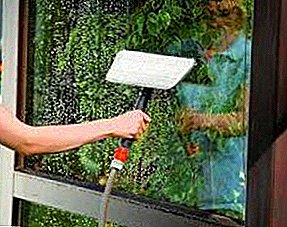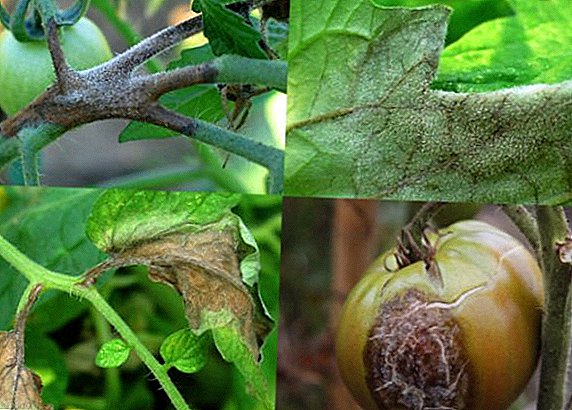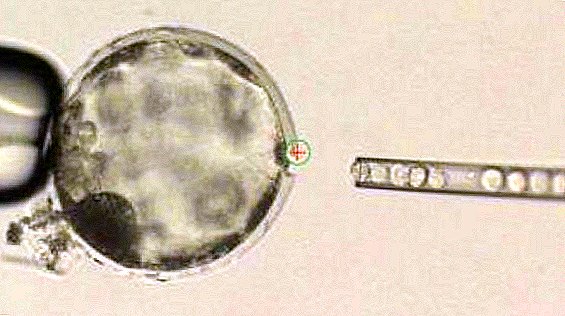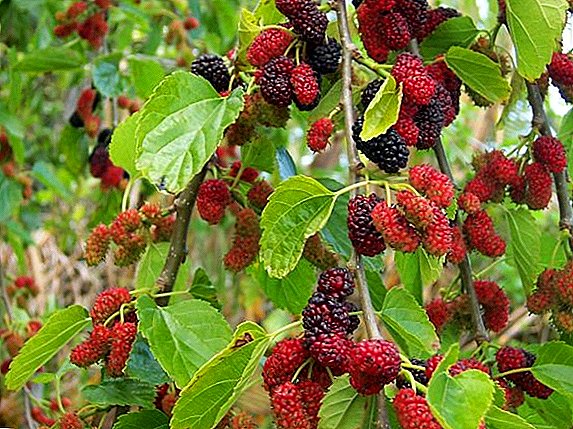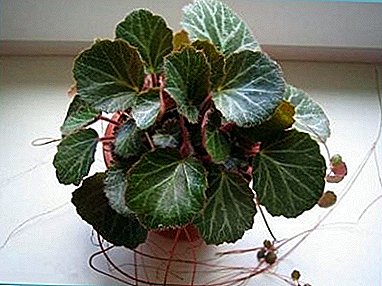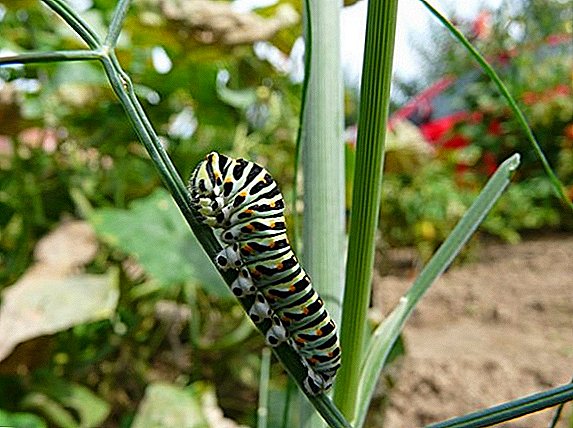 In nature, there are no insects that feed on dill alone, but there is an impressive list of pests that prefer to settle on plants of this family: parsley, carrots, celery, and others.
In nature, there are no insects that feed on dill alone, but there is an impressive list of pests that prefer to settle on plants of this family: parsley, carrots, celery, and others.
However, there are also such insects, which, among other choices, prefer this particular plant, therefore they are called pests of dill. What are these creatures and how to fight them, we will tell further.
Difficulties in handling dill with chemicals
 Both the underground parts of the plant and the ground can be attacked. To the roots threatened by a bear, caterpillars, larvae of the May beetle, wireworms and other insects.
Both the underground parts of the plant and the ground can be attacked. To the roots threatened by a bear, caterpillars, larvae of the May beetle, wireworms and other insects.
Greenery affecting bedbugs, aphids, cicadas, ticks, thrips and other land dwellers. However, whatever the pests of dill, the fight against them is conducted only by popular methods.
When growing plants for consumption it is forbidden to use pesticides and any other chemicals, because it is used for food, often without prior heat treatment.
Did you know? In most cases, dill is used as a seasoning. Its greens are added to mushroom, vegetable, fish, meat dishes, as well as to gravy, sauces, soups, salads. Moreover, they are added immediately after the preparation of the dish, since after heat treatment it loses its flavor. Flowering umbrellas are used in the preservation and aromatization of vinegar. Dried herbs are used not only as an independent seasoning, but also added to the mixture of herbs.Therefore, taking into account these facts, pesticides can be used only if dill is grown for seed.
How to deal with aphids on dill
 Often affects dill carrot aphidwhich mostly likes to settle on an orange and healthy root vegetable. This is a translucent small greenish insect that feeds on plant sap, can be found on dill greens, from where it is difficult to get it before using the plant for food. The insect itself is not poisonous, but not everyone is happy about the opportunity to eat dill with aphids.
Often affects dill carrot aphidwhich mostly likes to settle on an orange and healthy root vegetable. This is a translucent small greenish insect that feeds on plant sap, can be found on dill greens, from where it is difficult to get it before using the plant for food. The insect itself is not poisonous, but not everyone is happy about the opportunity to eat dill with aphids.
Important! In addition to pests, the danger of dill is represented by various diseases, especially in greenhouses. Therefore, when growing dill, strictly adhere to the technology of this process. Take particular care with growing in greenhouses: water moderately, often air, hold humidity at 50%, and temperature - + 15 ... 20 ° C].Control measures with the described dill pests consist in spraying the crops with various tinctures: for example, from tomato or potato leaves, tobacco. Aphid has a very thin cover through which even the weakest funds pass.
Potato tops Solanine contains poison, which has a detrimental effect on tl, therefore, in order to prepare an infusion, it is necessary to take a half to two kilograms of the vegetable part of potatoes or tomatoes, chop them up and pour a bucket of water.
Then the mixture is boiled for half an hour or insist for at least three hours. After that, it remains to add 30 - 40 g of grated soap or 30 ml of liquid, which will hold the infusion on the plant and distribute it well. Spraying is carried out in the morning and evening.
In the tobacco plant Nicotine is destructive of the insect. In this case, to make an infusion, 100 g of the leaves of the plant are crushed and poured with a liter of water. It is necessary to insist it for a day, then strain and add soap too. As a basis, you can use the ground part of the celandine, hot pepper, feverfew. After spraying dill, before direct use, it must be rinsed well under a strong stream of water.
Measures to combat dill moth
 The insect is also known as carrot moth. This is a small, up to 19 mm butterfly with red-brown front wings. In total, there are more than 100 of its species, so it may look different from the one that has already been dealt with before.
The insect is also known as carrot moth. This is a small, up to 19 mm butterfly with red-brown front wings. In total, there are more than 100 of its species, so it may look different from the one that has already been dealt with before.
Caterpillars of the insect, which represent the danger of dill, have a reddish tint, which is slightly green between the segments. Depending on the climatic conditions, one female for a year can breed from one to three generations of small parasites.
The danger of an insect is that its caterpillars settle in the umbrellas of a plant, eating buds and young seeds, weaving and fastening umbrellas. Actually, hence another name of the pest - umbrella moth
Usually, it does not go to a serious fight against insects, since the affected plant is immediately removed and burned. It is important to shoot healthy dill umbrellas in time, and as a preventive measure, destroy wild umbrella crops in the area so that the insect does not fly over to your site.
Carrot leaf and dill
 Carrot listobloshka - an insect with a little green body, up to 2 mm in length and webbed transparent wings. It has red eyes, long filiform antennae, jumping hind legs. Laying white spindly eggs, which grow yellow as they mature. For a year, a listoplicle reproduces one generation. Overwinter on wild carrot or pine needles. Activation of females after the winter occurs in May.
Carrot listobloshka - an insect with a little green body, up to 2 mm in length and webbed transparent wings. It has red eyes, long filiform antennae, jumping hind legs. Laying white spindly eggs, which grow yellow as they mature. For a year, a listoplicle reproduces one generation. Overwinter on wild carrot or pine needles. Activation of females after the winter occurs in May.
This pest is dangerous at all stages of its development. Nymphs, larvae and adults actively suck the juice from the stem and leaves of the plant. More often settle on young shoots, so the dill stops growing, the greens curl and deform, and then dry.
Important! It is better to immediately use preventive measures against this pest of dill, so that later you don’t have to think long about how to fight it in a more serious way. It is important to remove all plantings of wild carrots and coniferous plantings near the place where dill is grown, and if this is not possible, cover the plants with spunbond or lutrasil at first shoots. As dill grows, it is necessary to loosen the soil, fight weeds and use other farming practices.
Control measures consist in spraying orange peels with infusions, tobacco dust or decoction of tobacco. To prepare the latter, you need to prepare a kilogram of tobacco or its waste, pour a bucket of hot water (not boiling water) and insist for 24 hours. In the filtered infusion diluted soap and already this mixture is sprayed with dill.
How to deal with the Italian bug
 This harmful insect is sometimes called striped shield. It is activated in late April, when adults emerge from last year’s plant residues and settle on the first plants. When the celery grows, they transfer to them, where they gradually lay eggs from the beginning to the middle of summer.
This harmful insect is sometimes called striped shield. It is activated in late April, when adults emerge from last year’s plant residues and settle on the first plants. When the celery grows, they transfer to them, where they gradually lay eggs from the beginning to the middle of summer.
This means that the insect larvae appear almost the entire warm period of the year. Like adults, they feed on the sap of flowers and young seeds, which greatly harm the crop.
The fight against grafizom striped (another pest name) does not require major activities. During the mating period, insects are densely deposited on the top of the plant, so they can be easily shaken into a bucket of water or completely pinch off the top and immerse it in water.
In order to prevent the occurrence of an insect at the site, it is necessary to destroy wild plants near it, which belong to the family of Umbrella, and also follow the rules of crop rotation and placement of celery.
Methods of dealing with carrot fly
 As already mentioned, dill like the main pests of carrots, among which carrot fly - a small brown insect with transparent wings. Fight her You can, scattering a special mixture in between rows of dill. For its preparation, they take in equal proportions slaked lime, wood ash and tobacco dust.
As already mentioned, dill like the main pests of carrots, among which carrot fly - a small brown insect with transparent wings. Fight her You can, scattering a special mixture in between rows of dill. For its preparation, they take in equal proportions slaked lime, wood ash and tobacco dust.
At least 5 g of the mixture must be used per square meter. The treatment is carried out two to three times every 8 to 10 days. He showed himself well in the fight against pests and the infusion of tomato tops prepared according to the above recipe.
As a preventive To repel an insect, spray the plant with infusion of garlic, onion, burdock, wormwood, yarrow or chamomile. To do this, take 200 - 300 g of the selected raw materials, finely chop and pour 2 liters of hot water (not boiling water).
It is necessary to insist the remedy for at least a day, after which it is filtered, and before using water is added (no more than a bucket) and 30-40 g of soap. The sharp smell from the used plants will remain within 4-5 days, which will scare away the fly.
Did you know? More hardy and less affected by pests are not thickened crops. Therefore, in time spend thinning beds and do not forget to ensure that they do not appear weeds. Watering should be moderate, without sprinkling. Carrot fly does not like peat soils, therefore, if there is a possibility of mulching with peat crumb, it is better to hold it.
How to protect dill from pests: prevention measures
The most important preventive measures in this case - compliance with the rules of growing dill. Remember that umbrella plants of a one-year cycle should be planted at a considerable distance from plants of the same family, but a two-year cycle. You also need to carefully remove all weeds that belong to the umbrella.
Be sure to remove from the site all the remnants of plants, fallen leaves, and dig up the soil for the winter. During cultivation strictly observe the agrotechnology and react in time to the appearance of unwanted insects.
Dill does not have especially dangerous pests, but sometimes insects settle on it, which are especially preferred by the plants of the umbrella family. To fight with them is simple. There are many recipes decoctions and infusions that effectively scare them.
 It must be remembered that chemicals and pesticides are not applied to dill, as it is used in unprocessed food. The best measures for pest control are prevention and, above all, proper plant farming.
It must be remembered that chemicals and pesticides are not applied to dill, as it is used in unprocessed food. The best measures for pest control are prevention and, above all, proper plant farming.


